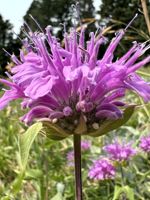Mon-Fri 9am - 5pm Mountain time
Wild Bergamot vs Beaked Sedge
Monarda fistulosa
Carex utriculata
NOT AVAILABLE THIS SEASON - MIGHT RETURN
CUSTOM GROW
Wild Bergamot is a native perennial wildflower that is known for its fragrant lilac-purple tubular flowers. The flowers grow in dense terminal heads and bloom from mid-summer to early fall. Deadheading spent flowers will encourage new blooms, prolonging its display. They attract pollinators such as bees, butterflies, and hummingbirds. It also serves as a host plant for the Raspberry Pyrausta (Pyrausta signatalis) butterfly.
Wild Bergamot belongs to the mint family, and its leaves, stems, and flowers are all edible. The leaves can be used to make tea or as a flavorful herb, with a taste often described as a blend of oregano and thyme.
It is resistant to deer and rabbits but can be susceptible to powdery mildew if planted too densely with poor air circulation. Wild Bergamot tolerates heat, drought, and poor soils, making it a low-maintenance addition to a variety of projects. It is well suited for pollinator gardens, wildflower gardens and naturalization projects.
Beaked Sedge is a native perennial wetland plant that forms dense clumps of tall, grass-like stems. It produces distinctive beaked seed heads that mature from late spring into summer. The plant provides food for waterfowl, muskrats, and other wildlife, while its dense growth offers cover for birds and small mammals. Its flowers and seed structures contribute to pollinator and invertebrate habitat in aquatic ecosystems.
Thriving in saturated soils and shallow water, Beaked Sedge is common in marshes, fens, and riparian zones. Its rhizomatous growth enables it to spread into large colonies that stabilize soils and support overall wetland health. Hardy and low-maintenance once established, it is well-suited to riparian plantings, naturalization, and ecological restoration projects.

